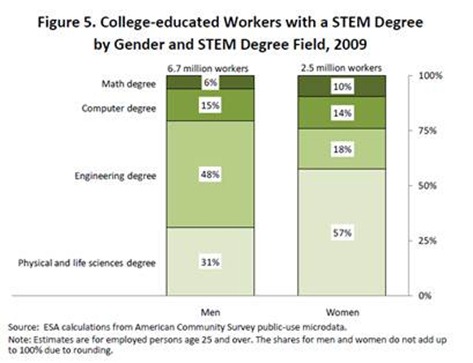Motivating College Students to be STEM Majors
Lili Cheng is general manager of Microsoft’s Future Social Experiences (FUSE) Labs
This summer my research team had six incredible interns, four women and two men. As they head back to college, and as I look at my own two high school aged children, I find myself wondering, what motivates young folks to pursue STEM (science, technology, engineering, and math) degrees and careers, and what can we do to make STEM and computer science more appealing to more people?
Getting the facts, according to the August 2011 study on the Gender Gap of Women in STEM from the US Department of Commerce, of 44 million college graduates with jobs in the US; there were only 6.7 million males and 2.5 million females with STEM degrees. Of those, only 2.7 million (40%) men and 0.6 million (26%) women work in STEM jobs. In other words, we could be doing better! Of 44 million college grads, only .6 million women have STEM degrees and STEM jobs.
Getting more facts, when we look at what motivates kids to get STEM degrees, it turns out the top answer is no surprise. The desire to earn a good salary with good job potential is the top reason kids (65%) study STEM, but the second rated reasons are fascinating:
Male students are more likely to pursue STEM because they have always enjoyed games/toys, etc. (51% vs. 35% females).
Female students are more likely than male students to say that they chose STEM to make a difference (49% vs. 34% males).
Also fascinating is discovering how kids get interested in STEM.
- More than half (57%) of STEM college students say that before going to college, a teacher or class got them interested in STEM. This is especially true of female students (68% vs. 51% males) who give “a teacher or class” as the top factor that sparked their interest. Female students in STEM are also more likely than their male counterparts to say they were extremely or well prepared for their college STEM courses (64% vs. 49%). While males may discover STEM interests outside of the classroom, females are finding their interests are supported in the classroom.
- For male students, it’s “games or toys” that top the list (61% vs. 29% females).
- With nearly three-quarters of STEM students reporting that their parents had at least some influence on their decision to study STEM, and females are more likely than males to say their mother was extremely influential and encouraged a lot.
To help increase motivation, given the above information, it would be good to know if increasing extracurricular STEM activities, toys and games for girls or if improving classroom curriculum and incentives would best increase passion and interest. Also, it would be great to give parents better guidance. For example, for parents who aren’t in STEM careers, how can they best motivate and encourage their children? It’s very hard to know what the best way to motivate a child is, even for parents like me with STEM careers.
Given I am a woman, and have one of the most exciting and interesting STEM jobs in the world, I want to help make sure there is awareness of the facts around STEM college majors and STEM jobs. I’d love to hear what kinds of programs people, especially educators and college counselors, find to be the most effective, and how we can better support the most impactful initiatives. If you have suggestions, we’d love to hear them!
Why not share you views in the comments below or reach out to me on Twitter using #STEMtember!
Lili
Lili Cheng is general manager of Microsoft’s Future Social Experiences (FUSE) Labs, which focuses on software and services that are centered on social connectivity, real-time experiences, and rich media. Previously, she was the director of the Creative Systems Group (CSG) within Microsoft Research.CSG developed several projects in the area of social computing and design, including Kodu, an Xbox 360 game to teach kids programming concepts; Salsa, a project that combines email and social networking concepts; and a project that rethinks how we view and share files within the operating system. Lili joined Microsoft in 1995, in the Virtual Worlds research group where she worked on social applications such as V-Chat and Comic Chat. |

